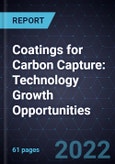Carbon Emission Mitigation from Non-point Sources Drives Development of Carbon Capture Coatings
Growing industrialization and urbanization have raised carbon dioxide in the Earth’s atmosphere from 393 parts per million (ppm) in 2012 to 414 ppm in 2022. As carbon emissions rise, so does the focus of governments and carbon capture and storage firms to develop novel strategies to mitigate carbon emissions. Regulatory bodies are expected to continue strengthening environmental policies in the next 5-10 years and imposing huge penalties on industries that fail to meet carbon emission standards. Conventional carbon capture technologies can reduce emissions from point sources, whereas direct air carbon capture technologies involve high implementation costs for non-point sources carbon emission mitigation.
Carbon capture coatings offer a promising application outlook to curb carbon dioxide emissions from non-point sources. The coatings represent a viable alternative to conventional coating systems for building and construction, aerospace and defense, automotive, general industrial, healthcare, telecommunications, and consumer electronics sectors. Stringent global emission norms also encourage the elimination of solvents with highly volatile organic compounds.
The industry is shifting toward bio-based technology that mimics the natural photosynthesis process for carbon capture. Micro-algae-based carbon capture coatings offer a promising application outlook for the automotive, general industrial, and construction sectors. Stakeholders will likely accelerate the technology commercialization and production scale in the next 2 to 3 years. Several polymer-based coating manufacturers exist in the market; however, polymer-based carbon capture coatings are in the final stages of development and expected to be available commercially in the next 3 to 4 years. As the industry evolves, the metal organic framework and nanoparticle-based carbon capture coating technology landscape are forecast to grow significantly in the next 4 to 5 years, mainly attributed to factors such as high carbon uptake, stability, and extent of applications.
Captured carbon can pave the way toward developing valuable downstream products such as low-carbon fuels and chemical intermediates, reducing the overall cost of these materials. Scaling up hydrogenation and molten electrolysis technologies will also give stakeholders a competitive edge in the market. Public-private sector partnerships are also anticipated to boost their investment in constructing carbon capture storage infrastructure, including pipeline networks.
The study provides an overview of carbon capture coatings material types and application trends. It includes factors driving the adoption and development of new technologies, their challenges, and adoption strategies for better utility. The commercial landscape of technological advancements in carbon capture coatings is also covered in this research, including noteworthy companies in action.
The publisher identifies key areas of technology development for carbon capture coatings in different domains, namely 1) Materials, including polymers, composites, nano and biobased; 2) Valorization technologies, including hydrogenation and molten electrolysis technologies; and 3) Application markets, including automotive, aerospace, power, building and construction. Companies increasingly focus on developing low-cost coatings formulations with efficient carbon capture ability without impacting mechanical and chemical performance. Strategic collaborations with research universities will play a crucial role in creating bio-based and nano-formulations with minimum environmental impact, thus promoting clean energy and circular economies.
Key points discussed:
- What are the emerging technologies for carbon capture coating technology?
- What are the R&D efforts in new material innovation for improved carbon capture uptake?
- What are the new carbon capture coating materials and application trends along with their commercialization stage?
- What are the growth opportunities for technology developers in carbon capture coating technologies?








